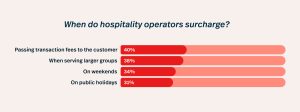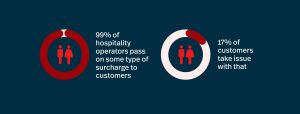
If you’ve visited a cafe or a restaurant in recent times, you’ll be no stranger to the concept of surcharges. They’re those small fees or percentages added onto your bill when it comes time to pay.
They can pop up periodically throughout the year in singular deluges—such as public holidays—or they can be part of your daily routine, adding a few cents on when you buy a morning coffee.
These extra few cents are ingrained into the hospitality industry with 99% of hospitality operators passing on some form of surcharge to their customers as a means to deal with the very real issue of mounting operating costs, something 17% of consumers take immediate issue with –Lightspeed Hospitality Report 2024.
That is why in this blog, we aim to address any negative feelings around surcharging and outline the rationale behind it.
Let’s dive in.
- Different types of surcharges
- How much do businesses profit from a surcharge?
- Where does the money go?
- Should a business surcharge?
Want more hospitality industry insights?
Download Lightspeed’s 2024 Hospitality Report today!
Different types of surcharges
There are different reasons for introducing a surcharge which, naturally, means that there are going to be different types of surcharges. However, there are two that are the most common: public holiday surcharges and surcharges on credit card and EFTPOS payments.
(i) Public holiday surcharge
For hospitality businesses and customers alike, public holidays often come hand-in-hand with a hefty price tag. These days bring in hordes of hungry patrons eager to celebrate, but they also trigger a spike in operating costs.
Wages rise significantly when an employee’s penalty rates kick in, raising their wages by 225% for part-time and full-time employees, and 250% for casuals.
There’s also the increased demand for supplies that comes with the influx of extra patrons, meaning that if a venue chooses to operate on a public holiday, they’re going to need to purchase more ingredients to meet the needs of extra trade.
Public holiday surcharges typically range from around 10% to 15% of the total bill
This typically involves a straightforward addition to the final bill for patrons dining out on a public holiday. The amount of the surcharge can vary depending on factors such as:
- The venue’s location – are they in a high-traffic area or are they more remote?
- The nature of the public holiday – is it a single day (like ANZAC Day) or multiple public holidays in a row (like Easter or Christmas)
- The specific costs the business is seeking to cover – are they looking to recoup some of their extra wages, or are they looking to mitigate some of the costs related to extra inventory?
How does a business decide on the percentage to surcharge?
For businesses, implementing a public holiday surcharge involves careful consideration of the balance between covering increased operating costs and maintaining customer satisfaction.
It’s also good to keep in mind that, without a surcharge a business would need to absorb the entirety of these extra costs whilst still trying to turn a profit.
For example, a full-time worker’s wages jump 225% from around $158 (the Restaurant Industry Award rate of $24.10, working a 7 hour shift) to around $379. A 10-15% surcharge doesn’t cover the entirety of these extra wages, but it does help.
(ii) Credit card and EFTPOS payments
Every time a customer opts to pay their bill with a credit or debit card, a small percentage of the transaction amount is charged by the business’ payment processor to process the bill securely. It’s usually a very small amount, but these do add up. Especially with most customers opting to pay by card – 76% of payments in Australia were made by card in 2022.
How much can the business surcharge customers?
Many businesses choose to pass these costs on to their customers in the form of a surcharge.
- For the customer, these extra few cents on top of the cost of their morning coffee allow them the speed and convenience of a cashless transaction.
- For the business, it’s a way for them to ensure that they’re not left out of pocket when it comes to covering these transaction fees.
Unlike the public holiday surcharge, there are limits set by the Australian Competition & Consumer Commission (ACCC) when it comes to businesses imposing a surcharge on credit card or EFTPOS payments.
A business is only allowed to pass onto the customer up to the amount their merchant charges for the transaction. This is set as a percentage usually around 1.5% (although American Express charges more) and, as such, most card payment surcharges are set to the same percentage the business is charged automatically.
This protects both the customer from being over-surcharged and any overzealous operators looking to exploit their customers.
It’s not a cash grab, surcharges are about keeping the business afloat
All of this being said, surcharging isn’t just about padding the business’ bottom line. In an industry where every cent counts, hospitality businesses are constantly on the lookout for ways to stay afloat in an increasingly competitive landscape. And a lot of time that means passing on a small fee to customers to help cover the cost of doing business.
It’s a delicate balancing act, but one that many businesses see as necessary, especially in an evermore cashless society.

How much do businesses actually make from a surcharge?
Hospitality businesses run on some very fine margins. For many, one bad week is enough to throw off the entire month and have the business owner hoping that next month will be better otherwise the doors might have to close for good.
Even so, hospitality operators regularly absorb a lot of costs (such as with coffee) in the interests of providing the best possible products and keeping their customers happy.
With this in mind, passing on some of the smaller overheads to the customer via a surcharge appears a very reasonable solution that suits both sides well.
Absorbing card surcharges would cost a cafe $8200 a year; while paying for a surcharge costs a customer $27 for the year
For example, if a merchant charges a business 1.5% on a transaction for a $5 cup of coffee (that works out at about 7.5 cents), that’s the maximum that the business can surcharge, in accordance with the law set out by the ACCC. That 7.5 cents gained via a 1.5% surcharge covers the business’ cost of accepting the payment.
Now, 7.5 cents extra doesn’t seem like a lot of money for a customer to pay once a day for their morning coffee, but consider the volume of card transactions a busy cafe puts through each year. Suddenly, that 7.5 cents becomes thousands of dollars to shoulder in the name of customer convenience.
Based on an average of 300 cups of coffee served per day, across a year that would incur merchant fees of around $8200 for a business. For a daily customer, these same merchant fees passed on as a surcharge would cost them $27.
The imbalance is clear.
Where does the money go?
There does appear to be somewhat of a disconnect between customers and businesses when it comes to understanding where the surcharge or extra money actually goes.
The money gained from these surcharges goes towards the maintained running of these businesses, although it is spread about in different ways.
With card payments, this is a pretty straightforward process. Because of the ACCC regulations, these surcharges are there to cover the cost of doing business.
While the public holiday surcharges are a little trickier to track, it’s relatively clear that any extra revenue gained from a surcharge covers all the additional costs that come with public holiday trading – such as higher staff wages, additional inventory, and even marketing costs for special events.
Should a business surcharge?

As always, the final decision lies with the business operator.
It does feel as though there needs to be more education so that customers are aware of where the extra money goes and how it supports a business to help keep the places they patronise and love open.
Adding a surcharge does run the risk of rubbing the customer the wrong way, but surcharges help make ends meet, covering the costs of paying staff fairly on weekends and public holidays, as well as absorbing the costs attached to card payments.
Without a surcharge, the risk is run on operating costs becoming out of control as operators try to find the funds to pay for their merchant fees, higher wage costs and increased inventory. It is worth noting that surcharging is something that 99% of operators already do.
Whatever you choose, check out Lightspeed’s 2024 Hospitality Report for more insights on the industry trends that will define the coming year.

News you care about. Tips you can use.
Everything your business needs to grow, delivered straight to your inbox.


